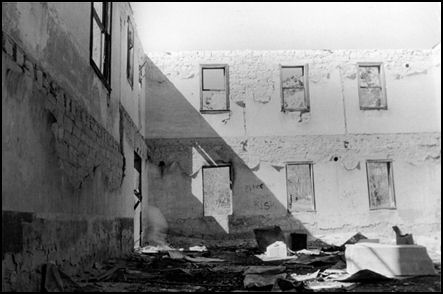
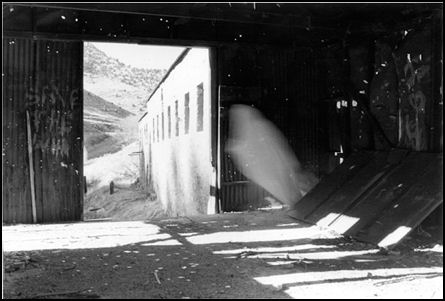
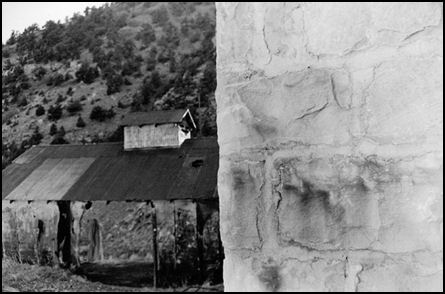
1. This Lady dressed in a beautiful white dress would float around the mining camp and lure the miners into the mine. If they followed the lady, it meant disaster....an explosion or cave in or some other accident.
2. Another story is that she would entice some men to leave the mine and thus avoid a disaster.
3. There is a story that her husband was killed in the mine and his body was never found and she wanders every night in the vicinity of the mine and inside the mine looking for the body of her husband.
4. For many of the miners, particularly the Welsh miners, there was much superstition about women in the coal mines. Any woman who came near the mine was bringing disaster. (This may come from the fact that in the first coal mines in Wales women were used to haul coal in baskets with straps attached around their head out of the low coal mines on hands and knees.)
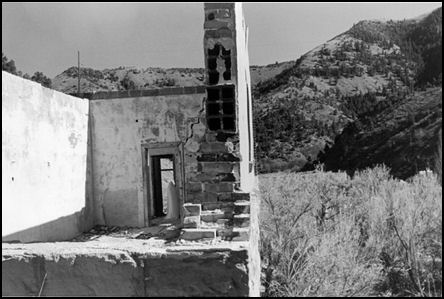
5. "Latuda is where one modern mining folklore talk began in the late 1960's. Teenagers would come back to the "haunted" mine office at night to tell ghost stories, and possibly catch a glimpse of the White Lady. One lad became agitated enough during the story telling that he acquired a blasting cap and blew part of the building down. This individual was sent to prison for the destruction of private property. Even after the office was blown apart, the most physical evidence of the town gone, the story persists.
Teenagers make frequent visits up Spring Canyon in hope of seeing the White Lady and scaring their friends. One story about the White Lady claims that her husband had been killed in a mine accident. The Company was to pay her a guaranteeed amount of money to help ease the struggle of trying to feed her family. The story claims that the mine office did not pay her the full amount that the Company had promised her. After a confrontation at the mine office, she was angry and driving too fast for the narrow winding road and ran off the road. The White Lady was supposedly killed in the accident. It is claimed that the White Lady roams the canyon to this very day seeking (deeming?) revenge on the mine officials. Some people believe that the White Lady really exists. Other claim that there is no such thing as the White Lady. Other people believe what people see is steam emitting from an underground spring when the temperatures have dropped enough to produce steam from a warm spring."
Copied from a history of Spring Canyon put together by K.C. Jensen and Richard Davies
Story told by Tony Slavensky Sr. to family and friends 1970's to 1980's:
In Spring Canyon, there was a family which consisted of a man and wife and two children, one boy and one girl. The husband and son were both killed in a mine accident. This left the woman to fend for herself and infant daughter.
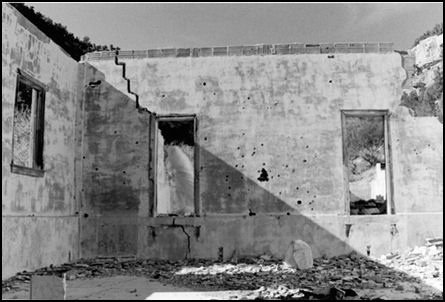
Three to four weeks later, the woman was washing clothes in the Spring Canyon wash and someone kidnapped the baby. The baby was thrown into the wash and drowned. The story says that the woman lost her mind and died and that she still searches the wash for the baby and seeks revenge for its death.
Story told to Janis O'Green Aberle by Claude Lambert, a retired coal miner from Spring Canyon. This story was told in the 1950's, but allegedly took place in the 1940's:
There was a couple living in the town of Peerless, next to a store that had overalls displayed in the window. The couple had one infant child.
The woman lost her husband in the mine, but not due to a mine accident, but from blood poisoning cause by an infected tooth. Since the death was not mining related, the mine company did not have to pay any compensation or benefits to the widow. At this time, there were also no welfare programs available. Destitute and starving, the woman did not want her child to suffer and starve to death, so she took it down to the wash and drowned it.
The woman then lost her mind and was instituted in the Provo Mental facility. She eventually escaped by means unknown and returned to Peerless to find her child. She eventually died and to this day still searches for the baby.
Claude Lambert lived in a rock house in Spring Canyon and he knew and worked with the man and also knew his wife.
Compiled and typed by Frankie Hathaway
 |
 |
For still another version of the White Lady check out the webpage for Clinton Thomsen called BonnevilleMariner. The article is titled "The White Lady: Ghostly Encounter in Spring Canyon."
This image of Helper Utah's Balanced Rock was taken by Charlotte Hamaker from the Sally Mauro Elementary with an Olympus SLR 35mm camera mounted on a high-power telescope in 1988.
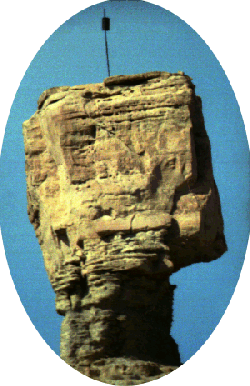
Helper's Balanced Rock is immense with a top of only 19 by 28 feet. The height of Steamboat Summit is 185 feet, the height of the Balanced Rock is 55 feet, and the gap between the rock and Steamboat Summit is 52 feet. Just making the ascent to the summit is a serious endeavor. About half way up the mountain, high winds often grab you and tugged at you. And in bridging the gap between the rock and cliff, you have to straddle a 16-inch eroding ledge, inching your way several hundred feet while avoiding a 600 foot drop on both sides. Once under the rock you have to climb a soft pedestal of clay and shale, and then the sandstone face. No small endeavor.
Only a few of Helper's oldest residents remember the fearless kids or young heros of the early Balanced Rock expeditions: Gordon Richardson, Rudy Felice, Arthur Sandviken, Ira Jackson, Bob Reddington, Frank Richardson, Chester Richardson, Dayton Kelly, Albert Marshall and William Marshall. This "Balanced Rock" gang, or some portion of it, scaled Balanced Rock some 252 times in the summer of 1929 and 1930.
For this gang, it all started in January 1929 when Gordon Richardson and Arthur Sandviken told their friends about their elaborate schemes for scaling the distinctive rock and of earning the $500.00 reward for putting up a flag and flagpole there. This rumor, heard by Richardson who was the oldest at age 21, had them all sitting and looking at the Rock one winter night. Finally one of them said, "Let's climb it." Gordon said, "Come summer we will." And then did even though they found out there was no reward. It seemed that Gordon's dream of putting a flag up there did not die with the rumor.
The initial climb up the rock, for they had been on Steamboat Summit before, was the hardest. Gordon Richardson, Arthur Sandviken, Frank Richardson, Albert Marshall and William Marshall looked for a way to make the climb up the face of the rock on May 12, 1929. Taking turns, they first threw a monkey wrench tethered to a 70 hemp foot rope as if it was grappling hook from the top of Steamboat Summit, to a crack on the top of rock. After assuring themselves that it was securely lodged, they dropped it into the saddle of the ridge. They now climbed down a chimney they found on the south side of Steamboat Summit and up to a narrow ledge on the pedestal, and on up the face of rock with the help of the rope. The materials for a canvas flag and pole then were passed across the gap with a pulley and hand line after being hoisted up the face of Steamboat Summit with a block and tackle.
The next eight hours were spent drilling a hole for a 1 1/4 inch pipe in the table-like top of rock. The pole then was placed in the cemented hole and secured with the rock drill placed in a nearby crack. As a town watched and cheered from the highway, the first flag was hoisted up the pole; but the 24 X 24 inch canvas flag fluttered for only 60 days.
But with persistence as their watch word, the group soon climbed the rock to put another flag over Helper. This time a regulation U.S. flag was used, donated by the Helper Y.M.C.A. The constant wind whipped this silk flag to shreds in only eight months.
But Gordon Richardson's dream would not die for during the winter of 1929-30 he spent untold time in the Utah Railway's Shop at Martin, building a flag that would resist the wind. It was made of iron, with a ball-bearing rotation mechanism that would move with the wind like a weather vane. He painted it with the stars and stripes. He again, with others of the group, hoisted it into place on June 19, 1930. The squeaking sounds emitted by the flag as it turned about the pole were heard by the town for only 48 hours. As the sounds grew, it snapped off the pole and bounced down the mountain, thus leaving only a small piece of blue on the pole.
Less than a week later they tried again. This time the flag idea was abandoned for an object that was heavy, stable and wind proof; a 100-pound, 55 gallon oil drum donated by Bryner's Service Station. After it was hoisted by block and tackle to the top of the rock, it was fitted over the old ball-bearing pivot and then filled with large rocks. The boys secured it with wires to the flag pole. After they crossed back to Steamboat Summit they shot holes into it for drainage and to reduce the wind resistance. For over 70 years this barrel perched above Helper's Balanced Rock.
Not all of the gang's trips to the top of Balanced Rock had a purpose though; sometimes they just fooled around up there. One of their favorite activities was to play sky ball. Using a baseball cap tied with string, Gordon Richardson and Rudy Felice for the most part, felt the top of the Rock was just large enough to play touch football; with their own rules of course. They would kick the make-shift ball and tag each other until it went out-of-bounds, and became a dead ball. Neither were quick to retrieve it to resume play however, for they were 1,000 feet above Helper and it meant an hour's hike.
Another activity they enjoyed was to race from the highway to the summit for chocolates, said Rudy Felice. One time, six of the boys which included himself and Gordon, timed their race. It took 32 minutes to scale Steamboat Summit and twelve minutes to return to the highway. Felice said that "Climbing the rock was just for fun for us, but Gordon took it more seriously."
Not many people climbed Balanced Rock after those two summers. Now-a-days, the eroding ledges and loose rock makes it impossible to climb without special climbing equipment. A few without the equipment have tried to do the climb, only to get stuck and call for help. In fact, in 1929 the gap was ten feet narrower between Steamboat Summit and Balance Rock, and the ledge of the pedestal was eight inches wider. Anyway, of those using special climbing equipment, only expeditions with experienced rock climbers have made it all the way to the top of Balanced Rock.
Frank D. Richardson, son of Frank Richardson, dreamed that someday he could stand where is father stood above Helper. After making several rock climbs elsewhere, he soon realized that he would need expert help to safely complete the task and contacted Merrill Bitter of REI in Salt Lake, to assist. Together they planned a 60th Anniversary Climb on Friday, May 12, 1989.
The Wednesday before the climb, Frank invited Shirley Haycock, daughter of Gordon Richardson, to join them. She too had dreamed of climbing all the way to the top, for she had made several trips to its base, but never to the top. And with only twenty-four hours notice she was there to meet the group at the trail head, traveling all the way from Freemont, California.
The group consisted of Frank Donald Richardson, his son Brad Richardson, Shirley Haycock, Merrill Bitter and Amy Irvine. Both Merrill Bitter and Amy Irvine are experts in the field, competing internationally. Both worked for REI of Salt Lake.
The ascent started unaided at 6:30 a.m. at the beginning of a treacherous trail that snaked its was up the north side of Steamboat Mountain to the bottom of the rock. The weather was partly clouded with intermittent wind and cold, thus making everyone wonder if the storm that was making in the west would hit before it was done.
Merrill made the ascent up the rock face first, placing pinions and anchors for safety. Taking his time he carefully climbed to the top. Frank Jr. came next, saying "I think I can, I think I can, I know I can," while listening to the shouted encouragement from his fellow climbers. His arms stiffened and his legs became quivering jelly before he reached the top and viewed the inscriptions left by the Balanced Rock Gang across the gap on the top of Steamboat Mountain.
Shirley Haycock at the age of 55 came next. She was the only one without special climbing shoes and this caused some minor problems for her. It took longer to climb up the face for her tennis shoes did not grip in the same way as climbing shoes did. Sometimes she struggled and got stuck, but she "conquered the rock an inch at a time," said Frank. As she was pulling herself over the lip of the rock she said, "If I was smart, I would act my age." But no matter, she plans to return for the 75th Anniversary Climb next year. She was the first woman to set foot on the summit of Balanced Rock.
Amy quickly climbed last, pausing only for a short time to glance at the original hemp rope coiled and sitting on the ledge of the pedestal that was used in the first climb up the rock.
After ascending, all four lingered to admire the view and to unfurl a Richardson banner for a short time. Finally they repelled down the rock to the saddle, where Franks son Brad, age 16, joined them and then repelled with them down the 150 foot north wall of Steamboat Mountain. Brad only went as far as the base of the rock for his job was to anchor the safety rope at the base as the others climbed.
A few years passed, and the next two expeditions to the rock became a lot more infamous. Only days apart, the first of these was done on Monday, August 14, 1995, when four experienced European climbers pulled down the barrel and planted a Welsh flag on top as a prank. Helper residents were outraged that it was not an act of nature that brought the barrel down, but what they called "an act of destruction." Several called 911 and demanded that the vandals be arrested, but the pranksters escaped home.
After an investigation, the culprits who were living in the Provo area were were contacted by the Helper Police Department and told to replace the barrel or face charges. They chose to quietly replace the barrel that they pushed down the side of the mountain two days earlier, but did not remove the flag. They never did admit that they were the ones that created the uproar.
The barrel was never the same, and near the end of April 2002, during a big windstorm the barrel came down permanently to lodge in an inaccessible place. There is talk of putting another barrel up there, but in the meantime someone put up another U.S. flag to fly over Helper, and as of February 2003 only a small portion of the blue field and a few short stripes remain.
Resources:
Balanced Rock Review, "Upper Limits", Helper, Utah, 19 Sep 1878.
Felice, Rudy, personal interview with author, Price, Utah, 12 Oct. 1998
Haycock, Shirley phone interview with author, Helper, Utah 3 Feb 2003
Historic Western Railroad and Coal Mining Center - Helper, Utah, The Balanced Rock Expedition, Peczuh Printing Co., museum flyer, circa 1985.
Robinson, Jim former Helper Police Chief, phone interview with author, Helper, Utah, 10 Feb 2003
Salt Lake Tribune, "Rock Climbers Topple Landmark, Leave Helper Over a Barrel", Salt lake, Utah, 16 Aug 1995
Sun Advocate, "Ascent to Balanced Rock", 23 May 1989, by Frank D. Richardson, Price, Utah.
Sun Advocate, "Prankster's Escapade Creates Uproar Among Helper Citizens", 17 Aug 1995, Price, Utah.
Helper Journal - 27 Aug 1964
On April 7, 2005 the amusement hall at Hiawatha was consumed by fire. This event caused some research to learn when it was built. In doing this research I learned that in 1913 there was an amusement hall built and then again in 1918 another amusement hall was built. If anyone has any information about this first amusement hall I would love to hear from you. I would like to know where it was and what happened to it.
Carbon County News - 3 Apr 1913
"Contractor Sherill, of Salt Lake, has just completed eight new cottages for the company and is now working on the Amusement Hall for the company employees, located between Hiawatha mine and East Hiawatha"
Carbon County News - 26 Jun 1913
"J.J. Wiegmann returned Saturday afternoon from a trip to Sunnyside and left that same evening for Hiawatha, where he attended the big dance in the new amusement hall just erected. He says the hall is a fine one and the dance was largely attended and was a swell affair. Refreshments were served to all who attended."
Carbon County News - 4 Jun 1915
Sam C. Sherrill, the Salt Lake City contractor, was in the coal camps south of Price the other day making figures with the company officials for moving the amusement hall and other buildings between East Hiawatha and Hiawatha proper to Black Hawk. The severity of the winters at the point mentioned and the isolation of employees concerned makes the move desirable.
News Advocate - 21 Feb 1918
BIG TIME COMING
Hiawatha Irish will have the assistance of all the rest of the camp and of hundreds from other camps in celebrating St. Patrick's day this year for the date will mark the opening of the big new amusement hall. The birthday anniversary of the saint comes on Sunday so the hall will be opened Saturday evening, March 16, (1918). Elaborate preparations are being made to make it the greatest social ever in the history of the camp. George Haymond was starting the ball to rolling when he was here this week.
The News Advocate - 17 Jan 1918
The amusement hall is going up gradually. The roof is on and most of the sides. It is reported that it will be completed about March first.
News Advocate - 14 March 1918
HIAWATHA AMUSEMENT HALL OPENS SATURDAY
Neatly engraved invitations, decorated with the Shamrock, have been received by scores of Price people and others all over the county bidding them enjoy the festivities at Hiawatha Saturday evening of this week in connection with the opening of the new amusement hall. The people of the United States Fuel camps have been waiting long for this big event, delayed on account of the difficulty in securing materials, but now that it is at hand they intend to make the most of it. The Hiawatha orchestra has prepared an extensive repertoire for the occasion and there will be many features aside from dancing for the pleasure of the visitors. Company officials from Salt Lake will be present as well as friends of the Hiawatha people from all over the county and it will be an evening of which even St. Patrick may be proud. On Monday evening, the Hiawatha Comedy company will present "All A Mistake" in the new hall for the benefit of the Red Cross. There will be a matinee for the children in the afternoon.
The Sun - 22 March 1918
VERY LARGE CROWD THE GUEST OF HIAWATHA AT NEW HALL DEDICATION
They produce hospitality as well as coal over at Hiawatha. and, more, they are adepts at dispensing it. If anyone should have the least doubt of it, he or she has only to interrogate some one of the eight hundred to a thousand persons who were there last Saturday evening as guest of the United States Fuel company management and residents of the big coal camp to attend the opening and dedicatory exercises of the magnificent new amusement hall just completed at a cost, including its rich furnishings, of around twenty-five thousand dollars. The building is the largest of its kind in Carbon county. Special trains were run from Castle Gate and from Mohrland at company expense, the attendance from the latter place being estimated at not less than two hundred. There were large crowds from Castle Gate, Helper, Price, Sunnyside and elsewhere, most of those attending making the trip by automobile.
Hiawatha amusement hall is forty-four by a hundred and ten feet in length 'from tip to tip.' Inside and on the second floor there is a dancing and seating space of forty-two by ninety-four feet, the balance of the building being taken up with a stage at one end and lobby, ticket office and cloak rooms at the other. Connected with the stage are commodious dressing rooms also. The electrical devices for use on the stage and elsewhere throughout the hall are second to none anywhere, the larger cities not excepted. The auditorium seats five hundred and fifty persons comfortably, and this capacity is capable of being increased two hundred to two hundred and fifty more if occasion requires. There is also a fireproof booth for the housing of moving picture apparatus. The great tarpaulin covers the floor when the auditorium is not in use for dancing. When dances are on this is readily and without inconvenience removed.
Below this main floor and reached from outside entrances is the same floor space given over to a bowling alley, pool and billiard and card tables, a gymnasium and refreshment stand. About the time the paraphernalia for the gymnasium was ordered the government came along and requisitioned all this kind of stuff for the boys in the army, and in consequence the gymnasium furnishings are as yet incomplete. This, however, will soon be overcome, when one of the very finest places of its kind anywhere West will be fitted out most completely. Adjacent to the gymnasium are shower baths and other conveniences for those who have just 'worked' out. Refreshment privileges are controlled by Carbon Emery Stores company with Lloyd E. Woods, formerly of Price, in charge. This department will be accessible during the day and evening.
F. C. Richmond, president of the Salt Lake City Commercial club, delivered a partriotic speech on the opening of the hall, which was cleverly and in a most happy vein responded to by E. Santschi, mayor of the town. The principal part of the evening, however, was taken up with a moving picture show. This consisted in the main of scenes at the mines of the company at Black Hawk, Hiawatha, Carbon and Mohrland, views along the Utah Railway, the Denver and Rio Grande and the general offices at Salt Lake City and also through California. The films were not only entertaining of themselves but educational to employes of the company and others as well. They had previously been exhibited in Salt Lake City, and it is understood are soon to be thrown on the screen at Price. No better pictures have ever been produced anywhere. They are in every and all respects to be classed among the very best. Following the pictures came a dance. At times there were as many as eight hundred people on the floor.
Visitors From Zion
Present from the general offices of the company at Salt Lake City was Moroni Heiner, vice president of United States Fuel company, and J.S. Critchlow, general sales manager of the company. The latter was accompanied by Mrs. Critchlow. Others were F. V. Curtis and George R. Smith, representatives of the corporation at San Francisco, Cala., and five young ladies of the office force at Zion. These latter were the Misses Marriott, Floodquist, Peachart, Cammomile and Wrengren. they were the guest of Vice Presdient Heiner. Present also from Salt Lake City were Mr. and Mrs. Ray McDonald and Mr. and Mrs. H. N. How and H. D. Randall and Robert Miller of the General Electric company. an elegant supper was served from a Salt Lake City caterer at the company hotel, two floors of the building being used for the banquet. Some two hundred and fifty persons were seated at one time.
Music for the occasion was furnished by the Hiawatha band of about twenty pieces and the Hiawatha orchestra. W. O. Miles is the leader of the former and Fred Von Elm of the latter. Both band and orchestra compare most favorably with the best anywhere, although each has been depleted of late by some of the boys being called to war. R. M. Magraw, general superintendent, was at his very best Saturday evening and mingling with the great crowd saw to it the each and everyone had a good time. He had a splendid lieutenant in the person of "Dad" Santishi. The doings at Hiawatha will be long remember as one of the very pleasant and most successful social events of Carbon county.
The several ladies of the reception committee are to be commended for their untiring efforts in making everyone feel at home and comfortable. The men of the committee also saw that all were taken care of as they should be.
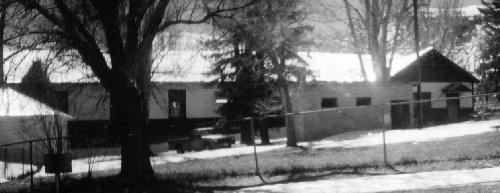
On April 7, 2005, eighty-six years later the Amusement Hall was destroyed by fire. You can read about the fire by visiting the Sun Advocate newspaper for April 12, 2005
This photograph was donated by Martin L. Hamaker and his daughter, Coreena Johnson. The photo was taken on Tuesday, April 5, 2005 just two days before the building was engulfed by fire. It is possible that this is the last photo taken of the amusement hall before it was destroyed.
Who is Minnie Maud named after? I have received information from three seperate families claiming that Minnie Maud is named after their relatives.
| Father: Richmond Beeman Thompson Mother: Affalona Galia Fausett Children: Laura Ann Thompson, born 1873, Tintic, Uintah, Utah Richmond Jackson Thompson, born 1874, Tintic, Uintah, Utah Byron Quincy Thompson, born 1877 in Ruby Valley, Uintah, Utah John Woodruff Thompson, born 1879, Scofield, Carbon, Utah Minnie Estella Thompson, born 1880, Scofield, Carbon, Utah Maud May Thompson, born 1884, Wellington, Carbon, Utah James Alfonzo Thompson, born 1886, Soldier Canyon, Carbon, Utah Florence Thompson, born 1888, Soldier Canyon, Carbon, Utah Benjamin Franklin Thompson, born 1889/90, Soldier Canyon, Carbon, Utah Samuel Thompson, born 1892, Price, Carbon, Utah Affalonna Thompson, born 1894, Green River, Emery, Utah Minnie Estella Thompson (1880-1922) and Richard Lee Rogers (1858-1950) and family. (It was Minnie Estella Thompson and her sister Maud Thompson, for whom the Minnie Maud Creek was named.) Reed Smith (son of Maud Thompson) had written in one of his writings that his grandfather, Richmond Beaman Thompson had purchased two ranches in the Argyle Canyon. He gave one to daughter Minnie, and the other to daughter Maud (my grandmother). My grandparents William Smith and Maud Thompson lived on the ranch that was given to her when they were first married in 1905. written by Patricia Thayer Muno From a book on CD available for this family. |
Father: Charles Ernest Hall Mother: Sarah Amy Babcock (a daughter to family #3) Children: Mary May Hall, born 1892, Spring Glen, Carbon, Utah Maud Hall, born 1893, Escalante, Garfield, Utah Minnie Hall, born 1893, Escalante, Garfield, Utah Ernest Hall, born 1895, Coal Creek, Carbon, Utah Jessie Myrtle Hall, born 1895, Nine Mile, Carbon, Utah Charles Ernest Hall, born 1897, Coal Creek, Carbon, Utah Myrtle Hall, born 1899, (Wellington, Carbon, Utah) Alvin Hall, born 1899, Wellington, Carbon, Utah Sarah Estella Hall, born 1902, Soldier Canyon, Carbon, Utah Minnie Hall was born Oct. 9, 1893 in Escalante, Garfield County, Utah. When she and her twin sister Maud was around three years old her family moved to Nine Mile Canyon and had a stage stop. The canyon Minnie Maude was named after these twins. Written by Peggy Chappell READ MORE INFORMATION ABOUT THIS MINNIE & MAUD HERE |
Father: John Rowley Babcock Mother: Augusta May Hanchett Children: Sarah Amy Babcock (mother in family #2)born 1875, Salem, Utah, Utah Maud May Babcock born 1877 Central, Sevier, Utah Minnie Babcock born 1879 Box Creek, Piute, Utah Josephine Babcock born 1881 Box Creek, Piute, Utah Daisy Babcock born 1883 Utah Dora Babcock born 1884 Helper, Carbon, Utah Mary Adelia Babcock born 1888 Vernal, Uintah, Utah John Babcock born 1891 Nine Mile, Carbon, Utah Belva Babcock born 1894 Harper, Carbon, Utah Earl Lorenzo Babcock born 1896 Harper, Carbon, Utah A quote from the article about Harper in the ghost town section follows: "According to government maps the name of the settlement is "Nine Mile", but according to Hank Stewart, an early rider of Mr. Lund, it was "Minnie-Maude", named for two girls who lived there in the early days." I believe the two girls Mr. Stewart is referring to are Minnie and Maud Babcock, daughters of John Rowley and Agusta May (Hanchett) Babcock. Maud married Carl Johnstun and was my grandmother. I don't have any information about Minnie other than she was born in 1879 in Box Creek, Piute, Utah. Written by Ralph Johnstun |
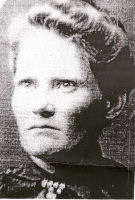 Minnie Hall |
During the summer of 1947, while hauling timber from Nine Mile Canyon to the Kaiser Steel mine at Sunnyside, Carbon County, Utah, just below the mouth of a place called "Minnie Maud Canyon", a place I had heard was named for my mother and her twin sister Maud, I was very surprised to see my friend from Wattis, Sheridan Powell. He was repairing a fence at the road side. I stopped just to say "Hello" but it turned into quite a visit.
Among the many things Sherd, as he was called, told me during this visit was this place where he was working was his old family homestead. His mother and dad had homesteaded the place and most of his brothers and sisters had been born and raised in the little log house there by the side of the road. He told me of a lot of the early history of that area - - how they had made their living there and how they used to do so much freighting through there with four to eight horse teams and sometimes ox teams on the big wagons. They hauled supplies from the railroad at Price to Fort Duchesne and the rest of the Uinta Basin and the Gilsonite mines and would then haul the sacked Gilsonite back to the railroad. He said they made a lot of their living by selling hay and grain and other supplies to the freighters, as they were called.
He then told me he knew the two girls that canyon had been named for. He said they were indentical twin daughters of Charles and Amy Hall, who had a homestead right at the mouth of the canyon. Their names were Minnie and Maud and they were their closest neighbors. He said he could still remember pleading with his mother as did his brothers and sisters to go up to Minnie and Maud's to play. He said they soon dropped the "AND" and it was "Minnie Maud" and that it had been Minnie Maud ever since. He said he could still remember how much fun it was for him to go up there as he got along real good with the Hall family, and what nice people they were, but his older sister didn't get along at all with them. Although she was only a little older than the twins, she would, "Just beat the ____ out of those two girls." Like a dummy I popped up and said "Minnie is my mother". He said "What did you say?" and I told him again that Minnie was my mother. I thought he was going to pass out, he was so shocked. Finally he said, "Well, when you see your mother again ask her if she can remember me and my sister," and he told me her name, which I have forgotten.
When I saw Mom again I ask her if she could remember them. She said, "Yes, I can and that girl had to be the meanest little ________ I ever knew. She had me and Maud bawling all the time." And just like Sherd had said, they were up there in their place a lot and Sherd was real good to get along with but his sister was something else.
I talked to Sherd on several occasions about this later on, both in the canyon and later when we both worked at Wattis. He was glad I had confirmed it with Mom, and that she had remembered it just like he had.
After Mom married Charlie Petitti, and was living South of Price. Sherd and Mrs. Powell were their close neighbors. I know they got together quite often, and they discussed this matter of "Minnie Maud Canyon" on several occasions. Mom told me of some of their conversations concerning these things. It is too bad they did not make some records of this.
During this summer of 1947, and later on several occasions, Harold and Nevel Wimmer of Nine Mile and Ted Housekeeper and Mel Keele also some or all of my brothers, Carl, Lou, Leon, Steve and Cli--. They all confirmed the fact that "Minnie Maud Canyon" got its name from the Hall twins of Minnie and Maud, identical twins who lived there at the mouth of the canyon. It should be fully understood by everyone concerned that Minnie and Maud were not born there. They were born in Escalante, Garfield County, Utah. On October 9, 1893, and moved with their parents Charles and Sarah Amy Babcock Hall to their new homestead early the following spring. This new homestead was only a few miles up the Nine Mile Canyon from Sarah Amy's mother and father, John Rowley and Agusta May Hanchett Babcock's, homestead at the mouth of Cow Canyon.
It was during the summer of 1970 while I was working for Eureka Sales Co. that I took Mom on a trip with me out to see our good customers Jack and Nevel Wimmer. This was the first time mom and the Wimmers had met, and it was a great occasion for everyone of us. The Wimmers were especially thrilled as they finally got to meet one of the twins they had heard so much about. The visit last several hours, and Mrs. Jack Wimmer fixed dinner for us at her Argile Canyon home. She felt it a great honor to have Mom, a person she had heard of for so many years, this distinguished visitor in her home. Jack said he was going to get one of his daughters who was a good writer to come with him to Huntington and see mom and get everything about this down on record. It was not very long after this visit that Jack had a sudden illness and died in, I think, a Salt Lake hospital before he got the records made. This trip out there with Mom was an all day trip as she showed me several things that have since turned out to be historical landmarks, including the old stage stops, one of which her mother and dad operated and another one former governor J. Braken Lee's folks ran. We stopped and looked them over as well as their old homestead at "Minnie Maud". What a wonderful day.
Signed
Lenard D. Brown